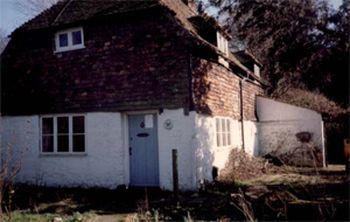2 Boys Hall Road, Willesborough, Kent - Building Report
Oxford Archaeology (South), 2011. (updated 2017) https://doi.org/10.5284/1044790. How to cite using this DOI
Data copyright © High Speed 1 unless otherwise stated
This work is licensed under the ADS Terms of Use and Access.
Primary contact
Stuart
Foreman
Senior Project Manager
Oxford Archaeology (South)
Janus House
Osney Mead
Oxford
OX2 0ES
UK
Tel: 01865 263800
Fax: 01865 793496
Resource identifiers
- ADS Collection: 2124
- DOI:https://doi.org/10.5284/1044790
- How to cite using this DOI
Introduction

The Oxford Archaeological Unit (OAU) was commissioned to carry out an archaeological investigation of the footprint and the curtilage of the Grade II Listed building at 2 Boys Hall Road, Willesborough, Kent (NGR TR 0258/4112). The work was undertaken on behalf of Union Railways (South) Limited, as part of the recording of listed buildings in North East Kent, due to be demolished in advance of CTRL construction.
Structurally, No. 2 Boys Hall Road was not fully investigated prior to its dismantling, since much of the historic fabric was visible within the building, and its interest was clearly apparent. Consequently there is no detailed information about some aspects of the building's construction, but it was inspected at the time of rebuilding (at Romden Road, Smarden, Kent) where it can still be seen.
The building is thought to have been constructed around 1600 and reused some medieval timbers. The plan is of two bays, of interest as an unusual small version of the new postmedieval plan type of lobby-entrance house. It has rubble stone walling in the ground floor and gable ends with clay tile hanging over timber framing in the first floor. There is a modern rendered brick outshot on the north side which conceals an earlier timber framed jetty with original wattle and daub panels. The roof is pitched, clad in clay peg tiles with two hipped dormers.
The excavations of the building footprint revealed five development phases of 2 Boys Road. Evidence of early activity (Phase I) is very slight, and the length of time between the demolition or abandonment of the medieval structures and the construction of the cottage (Phase II) is uncertain. The cottage is thought to have been built consecutively in the early to mid-16th century, and at a later phase possibly in the mid-late 16th century (Phase III), encountered further modfications. To the rear of the house an extension or ancillary structure was added in the early modern period (Phase IV), and a fireplace inserted in the late-18th or beginning of the 19th century. In the modern period (Phase V) the house was extended to the north-east and the area around the cottage landscaped.
In addition to the main excavations two test trenches were opened to evaluate the archaeological context of the building and to assess whether any archaeological deposits survived. These mainly revealed modern deposits although a second trench also contained features associated with earlier phases.
An Archaeological Evaluation (ARC BHR 97) was also undertaken at Boys Hall Road prior to the building survey, and a second building survey was completed at 4 Boys Hall Road as part of CTRL phase 1.






